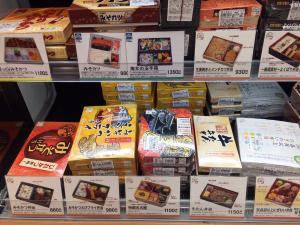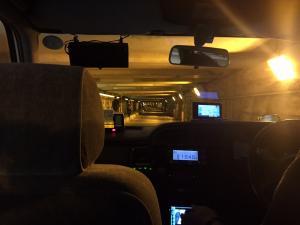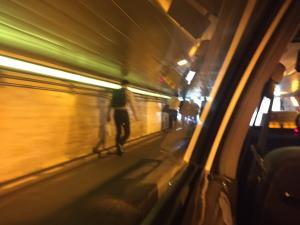I am writing this blog post while I’m on what will be my last Shinkansen (bullet train) journey for awhile. In less than three weeks, my family and I are moving back to our permanent home in the San Francisco Bay Area after a year and a half of living in Tokyo.
I am feeling nostalgic that my time in Japan is coming to an end, but I know that my experiences in Japan are not over. I already am planning a trip back in October for our friends’ wedding, and I have some potential work opportunities that might bring me back in 2017. I’ve been bitten by the Japan bug and I’m not ready for this experience to end.
[Note: this post was written 5 days ago. I am in the throes of my final two weeks of living in Japan and am capitalizing my on my time here, plus hosting our final visitors, “sayonara” events, and getting ready for packing up our apartment a week from today. As of this posting, we leave Japan in less than two weeks.]
Today’s final excursion to Nagoya via bullet train
Today I visited my friend and mentor Mr. Yoshino in Nagoya and had an unexpected excursion, and met again with my colleague from Toyota Memorial Hospital who shared more details about the practice of kaizen and hoshin kanri at the hospital. Stay tuned for more in-depth reflections about my conversations with both Toyota leaders in future posts.
I have so many observations and learnings from recent experiences that I want to write about, and they will come, but right now as I sit on my last Shinkansen journey as a resident of Japan, I want to reflect on my love of train travel in Japan.
Cloudy day, but Mt. Fuji can still be seen in the distance. On Shinkansen to Nagoya to visit Mr. Yoshino now. pic.twitter.com/Vdk9W4NiiW
— Katie Anderson (@kbjanderson) May 24, 2016
Shinkansen wa seguoi desu ne! (Bullet trains are cool, aren’t they?!)
I wrote a post a year ago about about my enjoyment of Shinkansen travel, and I still feel the same love a year later. This will be one of many conveniences of life that I will miss when I return to my car-based life in the United States.
It’s not just bullet train travel that is so convenient in Japan, but all public transportation for the most part. But bullet trains are really the coolest.
I still get a bit excited when the Shinkansen “whooshes” in and out of the station. I got a little sad as this train pulled into the station, as I knew I wouldn’t be riding one for at least 5 months.
Boarding my last Shinkansen for awhile. 🙁 I will miss traveling by bullet train! #Japan pic.twitter.com/4azqXMyTh6
— Katie Anderson (@kbjanderson) May 25, 2016
Electric “mamachari” bikes are cool too
Note, in additional to train travel, I’m a convert to electric bike transportation after a year cruising around Tokyo on a ubiquitous “mamachari” bike. I’m selling mine here and buying a new one in California, so hopefully I can not be car-bound all the time.
I can’t control the availability of convenient and fast train transportation, but I can commute by bike more often. I’m a cyclist for exercise, and look forward to commuting more easily by electric bike.
Constant movement
I remarked this morning on Twitter that I am continually astounded by the volume of people streaming out of Shinagawa Station (my usual point of departure) in the mornings.
The number of people that pass through #Tokyo train stations daily always astounds. Photo can't capture the flow! pic.twitter.com/9rFufiVV6g
— Katie Anderson (@kbjanderson) May 24, 2016
Still photos don’t do justice to the steady pouring of thousands of people in black suits and white shirts out of the station.
Of the 51 busiest train stations in the world, all but six are in Japan!
Collin McLaughlin replied to my Tweet and said he heard that over 3000 trains out of Tokyo Station daily. I believe it! People MOVE on the trains.
Check out the photo of the train schedule I just took in Nagoya before boarding the Shinkansen that I’m on. There is a bullet train that leaves for Tokyo nearly every 10 minutes – and it only takes 90 minutes to travel 330 kilometers!
4 bullet trains from Nagoya to Tokyo in 18 minutes. That's a lot of people moving quickly tonight! pic.twitter.com/0S9GiYElk9
— Katie Anderson (@kbjanderson) May 25, 2016
Clean and comfortable
Bullet train travel is smooth and incredibly punctual, the seats are comfortable with lots of leg room and electric outlets, and train attendants roam the cars selling concessions. If you are traveling as a group, you can rotate the seats around to face each other.
As with everywhere in Japan, all employees are incredibly polite and respectful. The conductors bow every time they enter or exit a car to check on tickets, as do the cleaners who wait at the station terminals to do a fast turn of the cars.
Also, in true Japanese form, the trains are very clean. When you leave the train, you take your trash with you and deposit it either in a bin on the train, or outside in one of the many categories required.
Lots of trash sorting rules in #Japan, but visual cues make it easier. Surprised these cans open w/G7 lockdown. pic.twitter.com/oRYuGvr3TV
— Katie Anderson (@kbjanderson) May 25, 2016
“Salaryman” meals
The stations are stocked with food halls and take-away convenience stores that sell bento boxes, drinks, and treats to take home. It’s not considered polite to eat while walking (or out in public generally), but consumption during long-distance train travel is the norm and catered to.

Morning
My morning routine when I go to Nagoya (which has been a lot in the past three months), is to buy a latte and pastry at the amazing bakery above the Station and then hop on the train. 90 minutes later I’m in Nagoya!
Evening
On the way home, there is a wide selection of bento boxes and Japanese treats. Tonight I opted for the “salarywoman” meal, substituting wine for beer!
Salary(wo)man dinner on the bullet train. Wine instead of beer. #japan pic.twitter.com/AIoE5RlMTg
— Katie Anderson (@kbjanderson) May 25, 2016
But Japan rail travel isn’t perfect…
The two main non-efficient or customer-orientated process that I’ve experienced in Japanese train travel are that:
- once you exit the train station and have to wait in an excruciating long line for a taxi (while an equally long line of waiting taxis are queued). This happens at EVERY train station I’ve been too….
- for non-Shinkansen trains, it can be very confusing to know what platform to go to. I had a recent experience that different ends of the SAME platform served different trains, but it was nearly impossible to tell this (especially as an only marginally literate Japanese reader).
But I’ll take those minor frustrations as the rest is really such a convenience and a delight.
Contrast this with U.S. domestic travel
What a contrast to domestic air travel in the U.S.
In the coming months I’m looking forward to visiting family and friends and traveling to teach with the Thedacare Center for Healthcare Value and for other professional events like the Lean Coaching Summit, but I’m not looking forward to the increasingly non-customer centered experience U.S. domestic air travel is and the increasing automotive congestion in the San Francisco Bay Area.
At least I’ll have my new electric bike when I’m in my local community!
The Shinkansen it too fast to accomplish much!
The train is so fast that we are nearing Shinagawa Station in just a few minutes. I’ll post this as soon as I can, after uploading photos and formatting in Wordpress.
One more part of my Nagoya routine
Okay, one side note that isn’t about the coolness of Shinkansen travel, but is part of my routine to get to Shingawa station. This fits in with the many contrasts and contradictions that I love about life in Japan.

The most popular taxi route to get to the Shinkansen entrance to the station is one that goes through a long dark tunnel under the train tracks. The tunnel must be less than 2 meters high, as people’s heads nearly touch the ceiling when walking or on bikes, and water is usually dripping down even on a nice day.

I love this slightly mysterious passageway that then deposits you to an escalator that leads up to the throng of exiting people and one of the most sophisticated train systems in the world.
Shinkansen travel, I’m going to miss you!











